 京公网安备11010802034965号
京ICP备13020181号-2
京公网安备11010802034965号
京ICP备13020181号-2
《中国塑料》编辑部 ©2008-2024 版权所有
地址:北京市海淀区阜成路11号 邮编:100048
编辑部:010-68985541 联系信箱:cp@plaschina.com.cn
广告部/发行部:010-68985253 本系统由北京玛格泰克科技发展有限公司设计开发

中国塑料 ›› 2023, Vol. 37 ›› Issue (9): 28-38.DOI: 10.19491/j.issn.1001-9278.2023.09.005
收稿日期:2023-03-28
出版日期:2023-09-26
发布日期:2023-09-18
通讯作者:
杜国勇 (1963-),男,教授,博士,硕士生导师,研究方向为油气田环境保护综合研究,guoyongdu@126.com作者简介:周龙(1994-),男,硕士研究生,研究方向为油水分离,1390928529@qq.com
基金资助:
ZHOU Long( ), DU Guoyong(
), DU Guoyong( ), DENG Chunping
), DENG Chunping
Received:2023-03-28
Online:2023-09-26
Published:2023-09-18
Contact:
DU Guoyong
E-mail:1390928529@qq.com;guoyongdu@126.com
摘要:
采用了一种简单、高效和环保的方法用于油水分离,即采用改进的Hummers法制备了氧化石墨烯(GO),通过简单的浸渍法和高温还原法将还原氧化石墨烯(rGO)先负载在三聚氰胺海绵(MS)上,再通过柴油加热MS,将长链烷烃负载在MS上,成功制备了超疏水⁃超亲油三聚氰胺海绵。rGO的加入能够增加海绵表面的粗糙度,长链烷烃的加入能降低海绵表面的表面能。改性MS具有良好的弹性性能、较好的热稳定性和吸油能力。油水分离性能测试表明,对各种油水混合物的分离效率可达97 %以上。在泵提供动外力时可实现无搅拌状态下的静态连续油水分离和搅拌状态下的动态连续油水分离。改性MS具有良好的可重复使用性和化学稳定性,在20次使用后对各种油水混合物的分离效率可达70 %以上, 即使在不同pH值的水中,也可以实现油水分离,对水包正己烷乳液也能有效地分离。
中图分类号:
周龙, 杜国勇, 邓春萍. 超疏水⁃超亲油三聚氰胺海绵的制备及其油水分离性能研究[J]. 中国塑料, 2023, 37(9): 28-38.
ZHOU Long, DU Guoyong, DENG Chunping. Preparation and performance of superhydrophobic⁃superlipophilic melamine sponge for oil⁃water separation[J]. China Plastics, 2023, 37(9): 28-38.
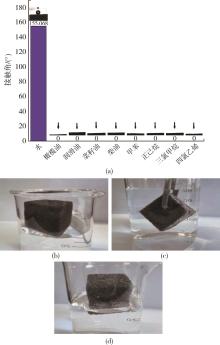

| 样品 | T5%/℃ | Tmax/℃ | 质量保留率/% | 质量保留率/% | 质量保留率/% | 质量保留率/% |
|---|---|---|---|---|---|---|
| MS | 86 | 392 | 94.8 (108 ℃) | 50.3 (440 ℃) | 19.4 (600 ℃) | — — |
| 柴油⁃MS | 67 | 377 | 91.4 (107 ℃) | 47.2 (430 ℃) | 20.4 (600 ℃) | — — |
| rGO⁃MS | 80 | 383 | 91.4 (140 ℃) | 68.4 (283 ℃) | 60.5 (424 ℃) | 44.5 (600 ℃) |
| rGO@柴油⁃MS | 124 | 389 | 95.6 (101 ℃) | 55.2 (407 ℃) | 29.4 (600 ℃) | — — |
| 样品 | T5%/℃ | Tmax/℃ | 质量保留率/% | 质量保留率/% | 质量保留率/% | 质量保留率/% |
|---|---|---|---|---|---|---|
| MS | 86 | 392 | 94.8 (108 ℃) | 50.3 (440 ℃) | 19.4 (600 ℃) | — — |
| 柴油⁃MS | 67 | 377 | 91.4 (107 ℃) | 47.2 (430 ℃) | 20.4 (600 ℃) | — — |
| rGO⁃MS | 80 | 383 | 91.4 (140 ℃) | 68.4 (283 ℃) | 60.5 (424 ℃) | 44.5 (600 ℃) |
| rGO@柴油⁃MS | 124 | 389 | 95.6 (101 ℃) | 55.2 (407 ℃) | 29.4 (600 ℃) | — — |
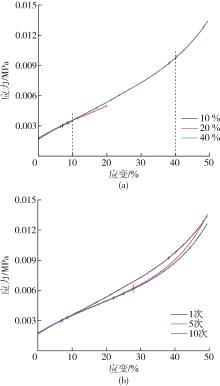

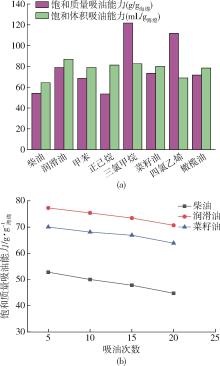

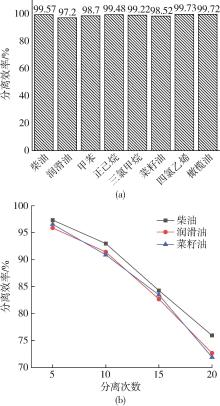

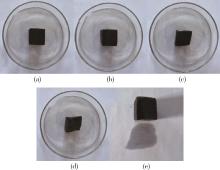

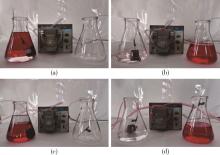

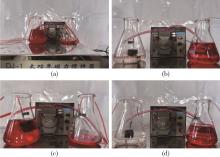

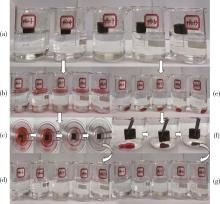

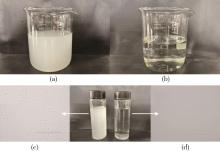

| 1 | Yi Jing Chan, Mei Fong Chong, Chung Lim Law, et al. A review on anaerobic⁃aerobic treatment of industrial and municipal wastewater[J]. Chemical Engineering Journal, 2009, 155:1⁃18. |
| 2 | Chen Peng⁃Cheng, Xu Zhi⁃Kang. Mineral⁃coated polymer membranes with superhydrophilicity and underwater superoleophobicity for effective oil/water separation[J]. Scientific Reports, 2013, 3: 2 776. |
| 3 | Li Bucheng, Wu Lei, Li Lingxiao, et al. Superwetting double⁃layer polyester materials for effective removal of both insoluble oils and soluble dyes in water[J]. ACS Applied Materials & Interfaces, 2014, 6: 11 581⁃11 588.. |
| 4 | Johanna Aurell, Gullett Brian K. Aerostat sampling of PCDD/PCDF emissions from the Gulf oil spill in situ burns[J]. Environmental Science & Technology, 2010, 44: 9 431⁃9 437. |
| 5 | Shen T. It′s all caused by oil spills⁃The most serious series of offshore oil spills in history[J] . Ocean. World,2010, 7:28⁃31. |
| 6 | Jin Meihua, Wang Jing, Yao Xi, et al. Underwater oil capture by a three⁃dimensional network architectured organosilane surface[J]. Advanced Materials (Deerfield Beach, Fla.),2011, 23:2 861⁃2 864. |
| 7 | Besharati Fard Moein, Donya Hamidi, Javad Alavi, et al. Saline oily wastewater treatment using Lallemantia mucilage as a natural coagulant: Kinetic study, process optimization, and modeling[J]. Industrial Crops & Products, 2021, 163: 113326. |
| 8 | Aisien F A, Hymore F K, Ebewele R O. Potential application of recycled rubber in oil pollution control[J]. Environmental Monitoring and Assessment, 2003, 85: 175. |
| 9 | Yang Jing Y, Yan Liang, Li Shao P, et al. Treatment of aging oily wastewater by demulsification/flocculation[J]. Journal of Environmental Science and Health. Part A, To⁃xic/Hazardous Substances & Environmental Engineering, 2016, 51: 798⁃804. |
| 10 | Ge Jin, Shi Lu⁃An, Wang Yong⁃Chao, et al. Joule⁃heated graphene⁃wrapped sponge enables fast clean⁃up of viscous crude⁃oil spill[J]. Nature Nanotechnology, 2017, 12:434⁃440. |
| 11 | Cheryan, M, Rajagopalan N.Membrane processing of oily streams. Wastewater treatment and waste reduction[J]. Membr Sci, 2015, 151:13⁃28. |
| 12 | Rubí H, Fall C, Ortega R E. Pollutant removal from oily wastewater discharged from car washes through sedimentation⁃coagulation[J]. Water Sci Technol, 2009, 59:2 359⁃2 369. |
| 13 | Zhu Shanshan, Xiang Qingchun, Ma Chunyan, et al. Continuous electrocoagulation degradation of oily wastewater with Fe78Si9B13 amorphous ribbons[J]. Ecology, Environment & Conservation, 2020,27:40 101⁃40 108. |
| 14 | Salahi A, Mohammadi T. Experimental investigation of oily wastewater treatment using combined membrane systems[J]. Water Science and Technology: a Journal of the International Association on Water Pollution Research, 2010, 62:245. |
| 15 | Wang Qianqian, Wang Hanghua, Xiong Sen, et al. Extremely efficient and recyclable absorbents for oily pollutants enabled by ultrathin⁃layered functionalization[J]. ACS Applied Materials & Interfaces, 2014, 6: 18 816⁃18 823. |
| 16 | Michael Nosonovsky, Bharat Bhushan. Biomimetic superhydrophobic surfaces: multiscale approach[J]. Nano Letters, 2007, 7(9): 2 633⁃2 637. |
| 17 | Patankar Neelesh A. Mimicking the lotus effect: influence of double roughness structures and slender pillars[J]. Langmuir: the ACS Journal of Surfaces and Colloids, 2004, 20(19): 8 209⁃8 213. |
| 18 | Parsaie Aliasghar, Mohammadi⁃Khanaposhtani Mohammad, Riazi Masoud, et al. Magnesium stearate⁃coated superhydrophobic sponge for oil/water separation: Synthesis, properties, application[J]. Separation and Purification Technology, 2020, 251: 117105. |
| 19 | Steven Zeng Zhi⁃wei, Spencer E Taylor. Facile preparation of superhydrophobic melamine sponge for efficient underwater oil⁃water separation[J]. Separation and Purification Technology, 2020, 247: 116996. |
| 20 | Zhang Ziyan, Liu Hai, Qiao Weichuan. Reduced graphene⁃based superhydrophobic sponges modified by hexadecyltrimethoxysilane for oil adsorption[J]. Colloids and Surfaces A: Physicochemical and Engineering Aspects, 2020, 589: 124433. |
| 21 | 周 龙, 杜国勇, 邓春萍. 氧化石墨烯纳米流体的制备及热性能研究[J]. 化工新型材料, 2022,50(10):160⁃166. |
| ZHOU L DU GY, DENG C P. Preparation and thermal properties of graphite oxide nanofluids [J]. New Chemical Materials, 2022,50 (10): 160⁃166. | |
| 22 | 侯绍行,王峰会,黄建业,等.荷叶在水下的超疏水状态的寿命测试与分析[J].科学通报,2016,61(07):735⁃739. |
| HOU S X, WANG F H, HUANG J Y, et al. Life test and analysis of lotus leaves in super⁃hydrophobic state under water [J]. Science Bulletin, 2016,61 (07): 735⁃739. | |
| 23 | Patankar N A. Transition between superhydrophobic states on rough surfaces[J]. Langmuir, 2004, 20(17): 7 097⁃7 102. |
| 24 | Xie J, Zhang J, Zhang X, et al. Durable multifunctional superhydrophobic sponge for oil/water separation and adsorption of volatile organic compounds[J]. Research on Chemical Intermediates, 2020, 46(9): 4 297⁃4 309. |
| 25 | Tang L, Wang G, Zeng Z, et al.Three⁃dimensional adsorbent with pH induced superhydrophobic and superhydrophilic transformation for oil recycle and adsorbent regeneration[J]. Journal of Colloid and Interface Science, 2020, 575: 231⁃244. |
| 26 | Pham V H, Dickerson J H. Superhydrophobic silanized melamine sponges as high efficiency oil absorbent materials[J]. ACS Applied Materials & Interfaces, 2014, 6 (16): 14 181⁃14 188. |
| 27 | Devallencourt C, Saiter J M, Fafet A, et al. Thermogravimetry/Fourier transform infrared coupling investigations to study the thermal stability of melamine formaldehyde resin[J]. Thermochimica Acta, 1995, 259 (1): 143⁃151. |
| 28 | Liu H, Geng B, Chen Y, et al. Review on the aerogel⁃type oil sorbents derived from nanocellulose[J]. ACS Sustainable Chemistry & Engineering, 2016, 5(1): 49⁃66. |
| 29 | Zhang C, Li Y, Sun S, et al. Novel magnetic and flame⁃retardant superhydrophobic sponge for solar⁃assisted high⁃viscosity oil/water separation[J]. Progress in Organic Coatings, 2020, 139: 105369. |
| [1] | 周龙, 杜国勇, 邓春萍. 超亲水⁃水下超疏油聚氨酯海绵的制备及其油水分离性能研究[J]. 中国塑料, 2023, 37(8): 28-37. |
| [2] | 陈淑花, 任子萌, 孙婷婷. 壳聚糖/壳聚糖接枝氧化石墨烯复合气凝胶的制备及性能研究[J]. 中国塑料, 2022, 36(9): 32-37. |
| [3] | 宋丹阳, 郑红娟, 李一龙. 聚乳酸基油水分离材料研究进展[J]. 中国塑料, 2022, 36(9): 187-192. |
| [4] | 马超群, 师文钊, 崔杉杉, 张曼妍, 周红娟. 聚乙烯醇基多孔复合材料研究进展[J]. 中国塑料, 2021, 35(4): 116-123. |
| [5] | 康炜, 刘喜军, 曹卫艳, 王宇威, 闫杰. PMMA/DEAM⁃RGO纳米复合材料的制备与性能测试[J]. 中国塑料, 2021, 35(1): 47-53. |
| [6] | 刘佳衡, 王冬琴, 胡盛, 胡卫兵. GO/AT复合材料的制备及其吸附性能分析[J]. 中国塑料, 2020, 34(5): 45-51. |
| [7] | 刘志, 吴波, 候广开, 阮方涛. 二甲基硅油增强聚甲基丙烯酸甲酯超疏水复合纤维膜制备及其性能研究[J]. 中国塑料, 2020, 34(4): 42-48. |
| [8] | 于翔 孙志恒 刘晓晗 王晨宇 韩任旺. PAN/TiO2-GO杂化纤维膜的电纺制备与分析[J]. 中国塑料, 2018, 32(11): 54-60. |
| [9] | 张玲, 陈寿, 孙耀明, 江洪, 王鑫, 涂建国, 李明雨. FGO-WPUPA光固化阻隔涂料的制备及其对PLA薄膜阻氧性能的影响[J]. 中国塑料, 2017, 31(08): 35-40 . |
| [10] | 李海燕, 李爽, 王奇, 崔业翔, 马英杰. 聚丙烯酸/氧化石墨烯自修复水凝胶的合成及性能[J]. 中国塑料, 2016, 30(11): 42-47 . |
| [11] | 丰佳平, 黄汉雄, 童俊, 吴敏. 水辅混炼挤出聚苯乙烯/氧化石墨烯纳米复合材料的微观结构及流变与热性能[J]. 中国塑料, 2016, 30(06): 79-85 . |
| [12] | 徐伟华 韦春 吕建 苏乐 曾思华. 热致性液晶聚合物/酚醛树脂/氧化石墨烯混杂复合材料的性能研究[J]. 中国塑料, 2013, 27(05): 56-59 . |
| [13] | 沙金 谢林生 马玉录 董树梅 王艳允. 氨基改性氧化石墨烯及其与环氧树脂的复合[J]. 中国塑料, 2011, 25(08): 28-33 . |
| 阅读次数 | ||||||
|
全文 |
|
|||||
|
摘要 |
|
|||||
 京公网安备11010802034965号
京ICP备13020181号-2
京公网安备11010802034965号
京ICP备13020181号-2